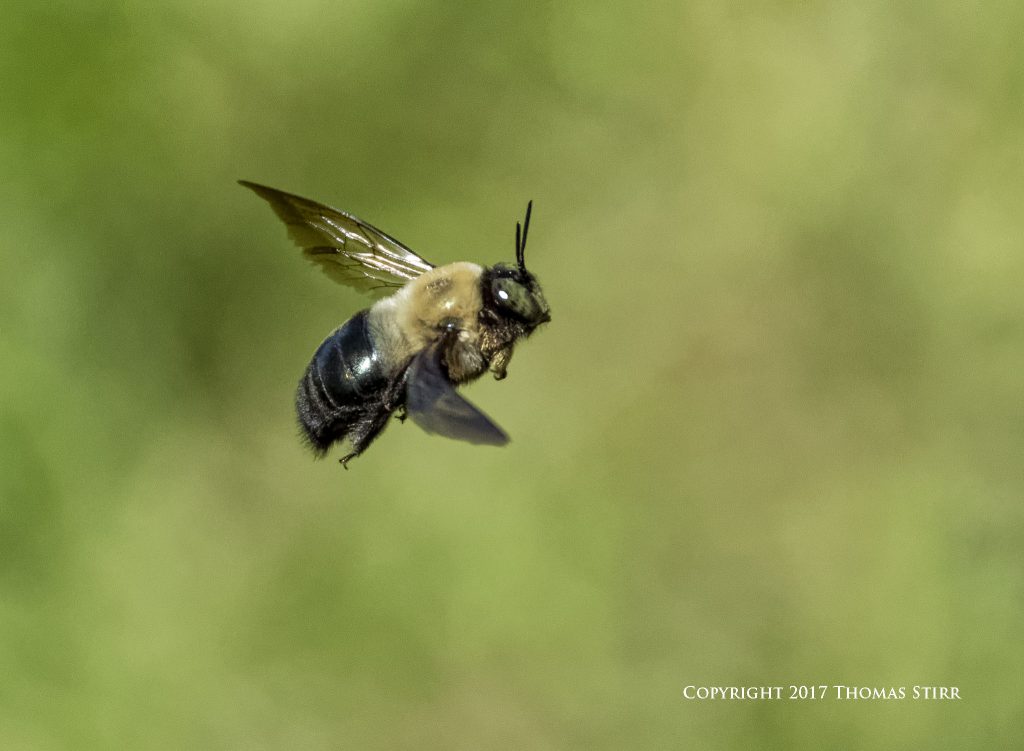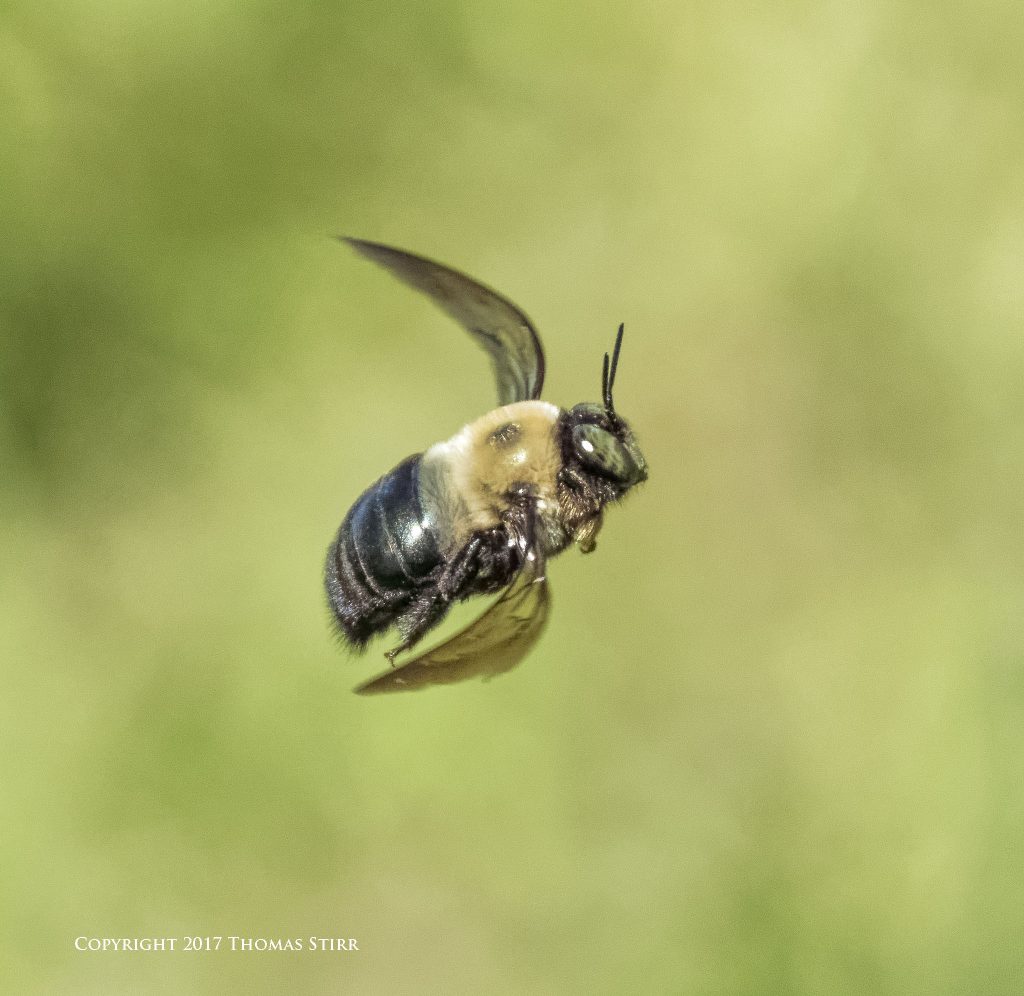On Saturday morning I was out at Ruthven Park in Cayuga Ontario. My intent was to photograph some hummingbirds or purple martins in flight. When nature did not cooperate I looked around for another challenge and ended up photographing bees in-flight, hand-held.
NOTE: Click on images to enlarge.

I’ve photographed bees numerous times in the past. On all of those occasions they have been reasonably stationary bees that were sitting on flowers. For those images I used extension tubes, most often with my 1 Nikon 30-110mm f/3.8-5.6 zoom. Typically I would compose images from the rear screen of my cameras. I anticipated that photographing bees in-flight would be a far different challenge.
I began by watching the bees in the area so I could get a feeling for their typical behaviours. I noticed that on one particular side of the birding hut at Ruthven, some of the bees would momentarily hover before darting off.

I calculated that I may have 1-2 seconds to capture images of a particular bee. This would entail getting my AF-C point on top of the bee, and attempting to keep it in place long enough to acquire focus. This was made a bit tougher since I planned to use my 1 Nikon 70-300mm fully extended, giving me an equivalent field-of-view of 810mm. I anticipated that some fairly quick eye-hand coordination would be needed.
I studied the shooting angles available to me and decided there were only two possible. The first was shooting down towards the grass in a well lit area, focusing on bees that were momentarily hovering as they approached flowers. The second was shooting up against the bright blue sky as the bees were hovering adjacent to the roof of the birding hut. Both of these shooting angles would produce uncluttered backgrounds.

I decided that shooting down towards the grass would result in more pleasing images. This would necessitate using a slightly slower shutter speed as the lighting wasn’t quite as bright. There would be much less contrast between the subject bee and the background, than would be the case when shooting up against the blue, cloudless sky. I figured this would make it harder to find the bee in my viewfinder.

My next thought was about shutter speed. I knew from my experience photographing hummingbirds in-flight that I would need a very fast shutter speed to ‘freeze’ the wing movements on a bee. I tried a couple of test AF-C runs at 1/4000 and 1/5000. As expected the wings were too blurry for my liking. I cranked my shutter speed up to 1/10,000 for the ‘grass angle’ images. I also did some tests using 1/13,000 and 1/16,000 shutter speeds for the ‘blue sky’ angle images. I found that using 1/10,000 gave me the look I desired – just a bit of wing blur.

I used my standard bird-in-flight camera settings. I shot in Manual with auto-ISO 160-3200, using AF-C with subject tracking, and with VR turned off. I tried shooting at both 10fps and 20fps. I decided that using 20fps would give me more chance of success, given the extremely limited time frame I’d have with which to capture images of a particular bee.

I had to keep my 1 Nikon 70-300mm pre-focused at the approximate distance at which I was expecting to photograph the hovering bees. In order to get the bees as large in the frame as possible I set my 1 Nikon 70-300mm to ‘full’. This allowed me to focus at a shorter minimum distance.

Overall, the experiment went decently well. As expected I did have plenty of missed shots, but I did end up with a reasonable number of acceptable AF-C runs during the hour that I spent at Ruthven Park.
All of the images in this article were subject to some aggressive crops. Given the small size of the bees I wasn’t expecting to get any images that would be usable for enlarged prints. Overall, I was pleased with the photographs that I was able to capture, finding them acceptable for this article.
Photographing bees in-flight hand-held was a challenging, little experiment. It’s one that I would have no problem doing again under the right light and shooting conditions.
Technical Note:
All images were captured hand-held using a Nikon 1 V3 and 1 Nikon 70-300mm f/4.5-5.6 zoom lens as per the EXIF data. All photographs used in this article were produced from RAW files using my standard process of DxO OpticsPro 11, CS6 and the Nik Collection.
My intent is to keep this photography blog advertising free. If you enjoyed this article and/or my website and would like to make a modest $10 donation through PayPal to support my work it would be most appreciated. You can use the Donate button below. Larger donations can be made to tom@tomstirr.com through PayPal.
Article and all images Copyright 2017 Thomas Stirr. All rights reserved. No use, duplication or adaptation of any kind is allowed without written consent. If you see this article reproduced anywhere else it is an unauthorized and illegal use. Posting comments on offending web sites and calling out individuals who steal intellectual property is always appreciated!


I had a decent result using 1/4000 second with a flash to freeze the wings. But I only got 1 out of dozens of pictures!
Thanks for sharing your experience Samuel!
Tom
🙂 Busy bees and you. You are brave to keep trying new challenges with your camera setup. Cute, chunky bees sure can move fast!
Thanks for your comment Joni! Those bees do move fast…I got my images during very short hovering!
Tom
Some of these beautiful images show wing warping. This suggests that the electronic shutter with about a 1/80 sec total image scan speed was being utilized? If the image of the bee was 1/10 of the image then the effective shutter speed for stopping action would have been about 1/800 second?
Hi Jim,
The most that a bee occupied in the frame was about 7.5%…some were only 5% of the frame. At 1/4000th of a second the wings were nothing more than a grey blob of blur with no detail at all.
Tom
Hi Tom,
We recently noticed we have bees nesting in one of the bird boxes in our garden. They are the garden bumblebee, which are protected in the UK; fortunately they are relatively docile, and the bird box is for obvious reasons a bit away from the house, so they aren’t a nuisance and we are leaving them be.
I took some photos of them to be able to confirm their type. I’m not going to publish any of the photos though, they are not a patch on yours!!! The bees move so quickly, it’s not until you try to take a photo that their speed of movement and erratic flight becomes apparent…
Maybe I will have another go once I’ve digested your article.
Regards, Dave R
Hi Dave,
Thanks for your comment and adding to the discussion! I also found that the majority of the bees were fast and very erratic flyers. After studying them for a little while I did notice two specific areas that seemed to elicit a brief hovering response from quite a few of the bees. I doubt that I would have been able to capture any images if I tried to photograph the totally erratic flyers!
Tom